The Dawn of Automation: A Historical Perspective
Future of Work
The Dawn of Automation: A Historical Perspective
Introduction to Automation
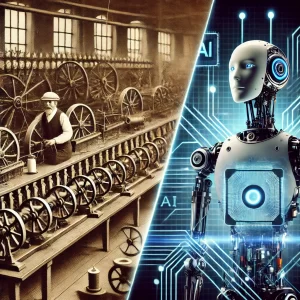 The relentless march of automation has been a powerful force in shaping the trajectory of human society, from the mechanized looms of the Industrial Revolution to the intelligent machines of today. What once started as a method to replace manual labor with machines has now evolved into sophisticated artificial intelligence systems capable of automating not only physical but cognitive tasks. The evolution of automation represents more than just technological progress; it highlights humanity’s ongoing pursuit of efficiency, productivity, and innovation. The McKinsey Global Institute has extensively researched and forecasted the profound effects of automation on the workforce, offering valuable insights into how industries and individuals can adapt to this ongoing transformation.
The relentless march of automation has been a powerful force in shaping the trajectory of human society, from the mechanized looms of the Industrial Revolution to the intelligent machines of today. What once started as a method to replace manual labor with machines has now evolved into sophisticated artificial intelligence systems capable of automating not only physical but cognitive tasks. The evolution of automation represents more than just technological progress; it highlights humanity’s ongoing pursuit of efficiency, productivity, and innovation. The McKinsey Global Institute has extensively researched and forecasted the profound effects of automation on the workforce, offering valuable insights into how industries and individuals can adapt to this ongoing transformation.
But what exactly is automation? And how did it evolve to where we are now? To understand this, let’s walk through the most significant machine breakthroughs that have paved the way for the intelligent automation systems of today:
•1784 – The Spinning Jenny: One of the earliest examples of automation in the textile industry. The Spinning Jenny allowed a single worker to operate multiple spindles, significantly increasing yarn production and marking a turning point in the mechanization of manufacturing.
•1793 – The Cotton Gin: Invented by Eli Whitney, this machine revolutionized cotton processing by efficiently separating cotton fibers from seeds, a task previously done by hand. The cotton gin accelerated the growth of the cotton industry, highlighting the growing role of machines in agriculture.
•1811 – The Luddite Rebellion: While not a machine breakthrough, this period was significant in highlighting the social resistance to automation. Luddites, textile workers who feared losing their jobs to machines, famously destroyed automated looms as a form of protest. This rebellion marked the first wave of societal opposition to automation.
•1830 – The Steam Engine in Transportation: Railways powered by steam engines enabled faster and more efficient transportation of goods and people, marking the beginning of large-scale industrial automation in logistics and transportation.
•1890 – Hollerith’s Tabulating Machine: This electromechanical device was used to process data for the 1890 U.S. Census, reducing the time needed to compile data by years. The tabulating machine laid the groundwork for modern computing and data processing automation.
•1913 – The Assembly Line by Henry Ford: Perhaps one of the most iconic breakthroughs in manufacturing automation, Ford’s assembly line revolutionized the auto industry by drastically reducing production time and cost. It also became a model for mass production across various industries.
•1946 – ENIAC (Electronic Numerical Integrator and Computer): The first general-purpose digital computer, ENIAC was a massive machine capable of performing calculations much faster than any human. This marked the dawn of computer-based automation and laid the groundwork for all subsequent digital technologies.
•1956 – Introduction of Robotics in Manufacturing: The first industrial robot, UNIMATE, was introduced by George Devol and Joseph Engelberger. Installed in a General Motors assembly line, UNIMATE could perform repetitive tasks such as welding and lifting, making it the first significant use of robots in manufacturing.
•1968 – Programmable Logic Controllers (PLCs): PLCs were introduced to automate manufacturing processes by allowing machines to be programmed with different instructions. This innovation eliminated the need for labor-intensive rewiring and significantly increased production flexibility.
•1970s – Automated Teller Machines (ATMs): The widespread introduction of ATMs in banking marked the beginning of automation in the financial services sector, providing a new level of convenience for customers and reducing the need for human tellers.
•1980s – Computer-Aided Design (CAD) and Manufacturing (CAM): These tools allowed engineers and manufacturers to design and produce goods more efficiently, enhancing precision and reducing errors in production processes.
•1997 – Deep Blue Defeats Garry Kasparov: IBM’s Deep Blue, a supercomputer, made history by defeating world chess champion Garry Kasparov. This event demonstrated the growing capabilities of machines to perform complex cognitive tasks, a precursor to modern artificial intelligence.
•2000s – Autonomous Vehicles and Drones: The 21st century saw rapid advancements in autonomous technologies, particularly self-driving cars and drones. These innovations marked a new era in automation, as machines began to take over roles traditionally performed by humans in transportation and logistics.
•2010s – AI and Machine Learning: The rise of artificial intelligence and machine learning led to automation systems that could learn from data, adapt, and perform tasks that go beyond simple repetition. This development paved the way for applications like virtual assistants, recommendation systems, and real-time analytics.
• 2016 – AlphaGo Defeats Lee Sedol: Google DeepMind’s AlphaGo made headlines when it defeated world champion Lee Sedol in the ancient board game of Go, a game considered far more complex than chess. This landmark victory was a major breakthrough in artificial intelligence, showcasing the ability of machines to handle intuitive and strategic thinking, marking a significant leap in AI’s capability to perform complex cognitive tasks.
•2020s – Robotics in Healthcare: Robotics made significant inroads into healthcare, with machines performing surgeries, assisting in diagnostics, and even providing rehabilitation. AI-powered robots are being used to analyze medical data, suggesting treatment plans, and improving patient outcomes.
•The Future – General Artificial Intelligence and the Singularity: While still theoretical, the idea of a future where machines surpass human cognitive abilities is gaining attention. General AI, unlike the narrow AI of today, could perform any intellectual task a human can do, leading to even greater levels of automation in every industry.
These significant breakthroughs showcase the relentless advancement of automation over time, evolving from simple mechanical tools to complex AI-driven systems that touch nearly every aspect of our lives. Understanding this progression is critical as we prepare for the next phase of technological disruption, where automation will reshape the global workforce in ways never before imagined.
Technological Milestones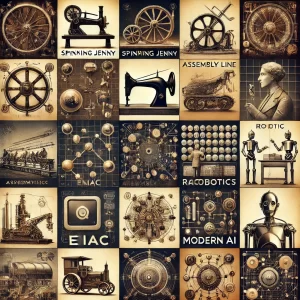
As illustrated in the timeline above, the journey of automation began with the first industrial machines—innovations like the Spinning Jenny and steam engines—which revolutionized manufacturing by replacing human labor with mechanized systems. These inventions increased production capacity while reducing the need for manual labor, sparking profound changes in the workforce. Throughout history, each major technological development has displaced workers, sometimes causing significant upheaval, but also laying the groundwork for new industries and job opportunities. Below is a deeper look at how various automation breakthroughs displaced workers and reshaped economies over time:
The Spinning Jenny and the Rise of Mechanized Manufacturing (1780s–1830s)
The Spinning Jenny, invented in 1764 by James Hargreaves, was one of the first major mechanized tools in the textile industry. Capable of spinning multiple threads simultaneously, it vastly outpaced the productivity of manual spinners. The result was a significant displacement of skilled textile workers. By 1790, it is estimated that tens of thousands of hand-spinners in England were put out of work, as factories employing machines began to dominate the industry.
The mechanization of the textile industry culminated in the Luddite Rebellion (1811–1816), during which displaced workers protested the growing use of automated looms, burning factories and destroying machines. The unrest underscored the tension between technological progress and its impact on the workforce. At the height of the Luddite movement, it’s estimated that around 50,000 workers were affected by job losses across the textile sector in England.
Steam Power and Transportation (1830s–1900s)
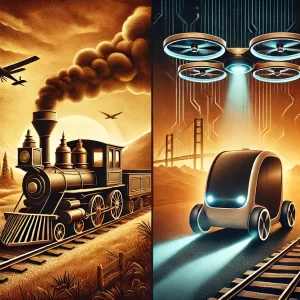 The introduction of steam engines revolutionized industries far beyond manufacturing. In the 19th century, steam-powered railroads transformed logistics, transportation, and shipping industries, leading to faster, more reliable movement of goods and people. However, as railways spread, there was also significant displacement in older industries like horse-drawn transportation. The rise of steamships and railways eliminated jobs for an estimated 200,000 workers involved in traditional horse transport across Europe and North America during the mid-19th century. Moreover, steam power increased productivity in coal mines and factories, reducing the need for laborers in those industries.
The introduction of steam engines revolutionized industries far beyond manufacturing. In the 19th century, steam-powered railroads transformed logistics, transportation, and shipping industries, leading to faster, more reliable movement of goods and people. However, as railways spread, there was also significant displacement in older industries like horse-drawn transportation. The rise of steamships and railways eliminated jobs for an estimated 200,000 workers involved in traditional horse transport across Europe and North America during the mid-19th century. Moreover, steam power increased productivity in coal mines and factories, reducing the need for laborers in those industries.
The Assembly Line (1910s)
The advent of the assembly line, perfected by Henry Ford in 1913, drastically reduced the time and labor needed to build automobiles and many other products. Ford’s Model T production line, for example, cut the assembly time from 12 hours per car to just 1.5 hours. While this innovation created many new manufacturing jobs, it also reduced the demand for skilled craftspeople who had previously handcrafted automobiles and other goods. It’s estimated that around 200,000 skilled laborers in manufacturing lost their jobs to automation during this period, as more and more companies adopted the assembly line model. However, these losses were partially offset by the creation of 500,000 new jobs in Ford factories alone during the 1920s.
Early Computerization and Data Processing (1950s–1970s)
The advent of early computers and data processing technologies, like the UNIVAC and IBM mainframes in the 1950s, marked the beginning of office automation. These machines could perform calculations and manage data much faster than any human worker, leading to the displacement of jobs in sectors like accounting, bookkeeping, and administrative support. By the 1960s, the number of typists and bookkeepers in the U.S. began to decline, and by the late 1970s, approximately 400,000 clerical jobs had been lost due to the automation of data processing tasks.
At the same time, the proliferation of early computers led to the creation of new jobs in IT, software development, and systems management, signaling a shift from low-skilled clerical roles to higher-skilled technical positions.
Robotics and Manufacturing Automation (1970s–1980s)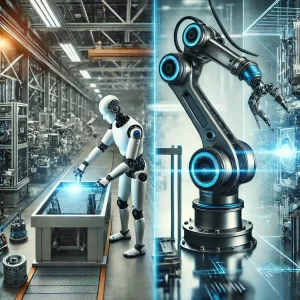
In the 1970s, robotics began to significantly transform manufacturing, especially in industries like automotive, electronics, and heavy machinery. The introduction of the first industrial robot, Unimate, in a General Motors plant in 1961 marked the dawn of the robot revolution in factories. By the mid-1980s, Japan had emerged as a leader in robotics, using industrial robots to automate a wide range of production tasks.
The widespread adoption of industrial robots in the 1970s and 1980s displaced approximately 1.2 million manufacturing jobs globally by 1990, particularly in assembly line work. In the U.S. alone, robot-induced automation displaced 300,000 factory workers in the automotive sector over this period. Although robots increased efficiency and lowered costs, they also created a need for fewer but more highly-skilled workers who could operate, maintain, and program these machines.
The Internet and Digital Automation (1990s–2000s)
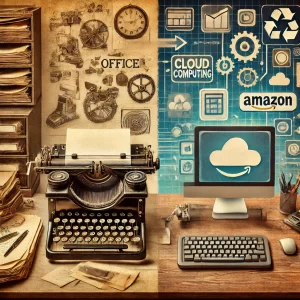 The advent of the internet and widespread adoption of personal computers in the 1990s marked the next major wave of automation. Digital tools like email, online banking, and e-commerce platforms automated many aspects of communication, financial transactions, and retail, displacing millions of jobs in areas like mail delivery, retail sales, and administrative work.
The advent of the internet and widespread adoption of personal computers in the 1990s marked the next major wave of automation. Digital tools like email, online banking, and e-commerce platforms automated many aspects of communication, financial transactions, and retail, displacing millions of jobs in areas like mail delivery, retail sales, and administrative work.
For example, the rise of e-commerce giants like Amazon in the early 2000s led to the closure of thousands of brick-and-mortar retail stores, displacing an estimated 2 million retail workers in the U.S. alone by 2010. Traditional banking also felt the pressure as 500,000 bank tellers were displaced by the increasing use of ATMs and online banking systems during this period.
AI and Machine Learning (2010s–Present)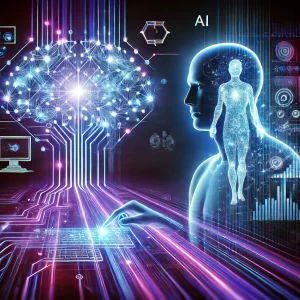
The 21st century ushered in a new era of automation driven by artificial intelligence and machine learning. These technologies have expanded the scope of automation far beyond repetitive, manual tasks. AI systems can now analyze vast amounts of data, detect patterns, and make decisions previously limited to human judgment. Industries like healthcare, finance, and legal services are being transformed by AI-powered systems capable of diagnosing diseases, recommending investment strategies, and even drafting legal documents.
This latest wave of automation has begun to displace white-collar jobs that were once considered immune to technological disruption. In the financial sector alone, it’s estimated that 1.5 million jobs in banking, trading, and financial analysis could be displaced by AI systems by 2030. Similarly, healthcare is seeing the rise of AI systems capable of automating radiology and diagnostics, potentially displacing 500,000 radiologists and diagnostic technicians globally by 2030.
At the same time, the rise of AI has created a demand for new jobs in AI development, data science, and robotics engineering. For every job displaced by AI, analysts estimate that three new jobs in AI-related fields could be created, though these jobs often require significantly different skill sets than those being lost.
.
Setting the Stage
![]() History shows us that technological disruptions always bring about significant changes, both positive and negative. During the Industrial Revolution, machines displaced many jobs, but they also paved the way for new industries, opportunities, and a vastly expanded economy. Likewise, the digital age has been marked by job losses in traditional sectors, while simultaneously creating demand for entirely new skill sets and industries, from software development to digital marketing.
History shows us that technological disruptions always bring about significant changes, both positive and negative. During the Industrial Revolution, machines displaced many jobs, but they also paved the way for new industries, opportunities, and a vastly expanded economy. Likewise, the digital age has been marked by job losses in traditional sectors, while simultaneously creating demand for entirely new skill sets and industries, from software development to digital marketing.
However, unlike past disruptions, the current wave of automation driven by AI and machine learning offers a unique opportunity for individuals to thrive by leveraging what makes us inherently human—our creativity, emotional intelligence, and ability to connect with others on a personal level. These traits, which machines cannot yet replicate, are increasingly valuable in a world where rote tasks are being automated. In fact, this may be the ideal moment to embrace the future of work by considering personal marketing businesses as a pathway to long-term success. In our previous blog, “Why Personal Marketing Businesses are the Future,” we explored how building a digital marketing business enables individuals to capitalize on their unique human skills, offering both autonomy and financial freedom in the age of automation.
While it’s easy to feel overwhelmed by the speed of change, there is tremendous hope for those who position themselves at the intersection of technology and humanity. The growth of automation doesn’t mean the end of meaningful work—it simply means that work will evolve. The key is to adapt and embrace the emerging opportunities. By focusing on areas that require human intuition, creativity, and emotional intelligence, you can work in coordination with machine intelligence to enhance productivity and impact.
Thriving in a Human-Centric Future: The Case for Digital Marketing, Coaching, and Network Marketing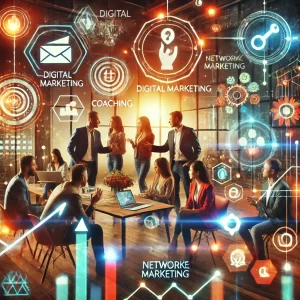
Consider industries like digital marketing, coaching, network marketing, and creative problem-solving, where humans are still far superior to machines. These fields not only offer security from automation but also align with the growing demand for personalized, value-driven work. Network marketing, in particular, stands out as an ideal career choice for the future. It allows individuals to leverage their personal relationships, communication skills, and emotional intelligence to build thriving businesses that cannot be replicated by machines. As automation transforms other industries, the need for human connection and trust will continue to drive success in network marketing, making it a robust option for those seeking financial independence and control over their future.
By embracing roles in digital marketing, coaching, and network marketing, individuals can capitalize on the unique advantages that humans hold—our ability to build meaningful relationships, foster trust, and provide personalized value—at least until the advent of Super Artificial General Intelligence (AGI), which remains a distant possibility.
As we stand at the cusp of this new era, the key questions remain: How will AI and automation reshape our jobs, industries, and economies? What specific opportunities exist for those willing to adapt? And perhaps most importantly, how can individuals and businesses leverage the technology while staying true to the core traits that make humans irreplaceable?
Understanding the history of automation helps us navigate the future. By looking at past disruptions, we can anticipate the changes AI and automation will bring to the workforce. More importantly, we can identify how to prepare, adapt, and thrive in an ever-evolving world. Embracing the growth of personal marketing businesses, leveraging human creativity, and staying ahead of the curve by focusing on skills machines can’t replicate yet, will not only prepare you for the future—it will position you to flourish.
Seize the Future: Preparing for Success in the Age of AI and Automation
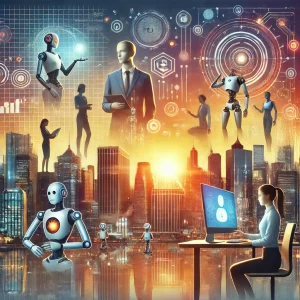 The dawn of automation was a pivotal moment in human history, and we are once again at the threshold of another transformation. From the mechanized looms of the Industrial Revolution to the AI-powered systems of today, automation has continuously redefined the way we work, live, and interact with technology. As we move forward into the age of intelligent machines, understanding the past provides valuable insights into shaping the future of work in a way that benefits both individuals and society.
The dawn of automation was a pivotal moment in human history, and we are once again at the threshold of another transformation. From the mechanized looms of the Industrial Revolution to the AI-powered systems of today, automation has continuously redefined the way we work, live, and interact with technology. As we move forward into the age of intelligent machines, understanding the past provides valuable insights into shaping the future of work in a way that benefits both individuals and society.
However, thriving in this rapidly changing landscape requires more than just understanding history—it demands preparation, adaptability, and the right mindset. Now, more than ever, is the time to invest in yourself and your future. You can take control of your destiny by mastering the skills that will set you apart in the age of AI and automation.
At Wealth Creation Mastermind, we offer the tools and guidance to help you navigate this transformative period. Through our online course, Mastering the Art of Wealth Creation: A Journey Through Mind Power and Marketing, you’ll learn not only how to leverage cutting-edge digital marketing strategies but also how to tap into the power of your mind to attract wealth and success in the modern world.
Don’t wait until the future is upon you—prepare for it now. Join the Wealth Creation Mastermind community, where you’ll find support, resources, and mentorship from industry experts who have successfully navigated the digital transformation. Enroll in our online course today, and start your journey toward mastering the art of wealth creation in the age of AI and automation.
The future belongs to those who are ready to adapt and embrace change. Will you be one of them?
#AutomationHistory, #AIDrivenWorkforce, #FutureOfWork, #NetworkMarketing, #DigitalMarketing, #IndustrialRevolution, #Robotics, #MachineLearning, #WealthCreationMastermind

John Rogers is a former Wall Street portfolio manager and served as CEO of Premium Enterprises and President of The Colorado Tire Recycling Center. He transitioned to digital marketing, founding WealthCreationMastermind.com to empower home-based entrepreneurs with cutting-edge strategies. Creator of the “Mastering the Art of Wealth Creation” online course, John has driven significant growth in network marketing, achieving the Blue Diamond rank and earning the title of Univera Associate of the Year in 2015. His expertise in leveraging technology for financial success transforms how entrepreneurs achieve their business goals.